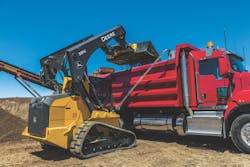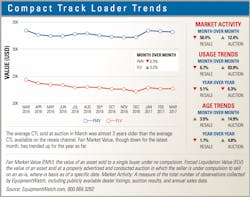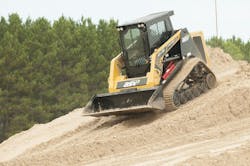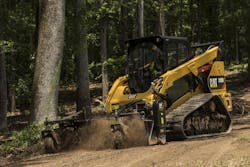Compact track loader (CTL) sales are still growing at the expense of skid steer loaders (SSL) and manufacturers have been busy adjusting CTL product lines with more sizes and more advanced models.
“The compact track loader market is up in North America by approximately 10 percent over the past 12 months,” says Gregg Zupancic, product marketing manager, John Deere Construction & Forestry. “Demand for compact machines that maximize productivity and uptime at lower daily operating costs is growing. CTLs are also easier to transport, fit congested work sites, and are popular with rental companies.
“There is also some migration to compact track loaders because of the added productivity they can provide,” Zupancic says. “Key productivity features include low ground pressure in soft ground or muddy conditions, as well as the ability to lift and push more because they have more weight and stability with the track system.”
Brent Coffey, Wacker Neuson’s product manager for loaders, agrees.
“The CTL continues to grow at a rapid pace. The growth is coming from a combination of cannibalization of the skid steer loader market as well as incremental market growth,” Coffey says. “Customers continue to see the additional work opportunities that the CTLs give them compared to skid steers, especially in dirt applications such as landscaping and construction. And CTLs can work regardless of weather with minimal ground disturbance. In these applications, skid steers will struggle with soft ground.”
But Coffey stops short of predicting the skid steer will one day drop to niche status. “Skid steers will always have a place in the market for a variety of reasons. For anyone concerned strictly about purchase price and cost of ownership, the skid steer will be preferred. In applications where higher travel speed is preferred, the skid steer will excel. Also, in applications where the machine will spend most of its time on a hard surface, the skid steer is a more ideal machine.”
“The fact that the skid steer market was down almost 6 percent is ample evidence to suggest that some buyers are opting for tracks rather than wheels,” adds Jorge De Hoyos, senior product manager, skid steers and compact track loaders, at Kubota. “There is still a price gap for similarly sized wheeled and tracked units favoring the wheeled units.”
Globally, CTLs have not eclipsed skid steers. “While rubber-track loader popularity has certainly increased in North America, skid steer loaders continue to be very popular, or even preferred, in many other regions of the world,” says Kevin Coleman, Caterpillar’s CTL product expert.
Cost of Ownership
Size class Avg. price Hourly rate* To 700 lb. $23,451 $16.07 701-975 lb. $25,279 $16.99 976-1,250 lb. $35,800 $23.22 1,751-2,200 lb. $54,606 $31.34 2,201 lb. & over $70,771 $37.16 *Hourly rate represents the monthly ownership costs divided by 176, plus operating cost. Unit prices used in this calculation: diesel fuel at $2.30 per gallon; mechanic’s wage at $56.67 per hour; and money costs at 1.875 percent. Source: EquipmentWatch.com, 800.669.3282
“Interestingly, the North American market makes up more than 90 percent of all CTL sales globally,” says Randy Tinley, JCB North America’s product marketing manager. “Additionally, rental companies are increasingly interested in offering CTLs, often to satisfy demand by ‘weekend warriors’ who need a versatile machine for domestic weekend projects.”
As a result of the bull market for CTLs, more than a dozen manufacturers offer multiple sizes in the category, up from what was seen just five years ago, and certainly from 10 years ago. OEMs’ model-line offerings are increasing. There are also newer players for managers to choose from, such as Wacker Neuson, and a trend toward larger machines with higher horsepowers.
Wacker Neuson entered the North American CTL market in 2014 with two units on the larger end of the spectrum, one radial-lift and one vertical-lift. In 2017, it added a smaller radial-lift and vertical-lift unit for a total of four CTLs.
Ten years ago, Gehl/Mustang had three CTL models (Gehl and Mustang apply their branding to the same products) that were third-party sourced. In 2012, they migrated to two different models produced on their own. This year, they have five different home-grown models, including a recently introduced vertical-lift CTL, the 114-horsepower VT320/3200VT.
“We didn’t offer any vertical-lift or tracked machines at all 10 years ago,” says Kevin Scotese, product manager, Volvo Construction Equipment. “Since customers are purchasing more tracked and vertical-lift models, we make four tracked models, two of which are vertical lift.” JCB is currently manufacturing CTLs for Volvo; they share the distinct single-arm configuration.
The largest OEMs are no different in reacting to market demands. In 2007, Caterpillar offered only five rubber-tracked models, two radial-lifts and three vertical- lifts. “Currently, there are 12 models, nine vertical-lift and three radial-lift, that comprise that Cat rubber-track loader line,” Coleman says. “Of the 12, five are offered with the multiterrain-style undercarriage and 7 are offered with the compact track loader-style undercarriage.”
Caterpillar’s two undercarriage styles differ in basic design. The multiterrain style is a suspended undercarriage featuring additional rollers with the objective being a smoother ride, more track on the ground, and lower ground pressure. Its CTL undercarriage, though also suspended, is heavier, with a higher ground pressure for less delicate underfoot conditions.
As track systems from a number of manufacturers have grown more sophisticated as the category matures and buyers become more savvy, good old horsepower has not been ignored.
“Though the John Deere model lineup is about the same, we’ve added more performance and horsepower,” Zupancic says. “Previously, the largest track loader was 86 horsepower, and now we’re up to 100 horsepower.”
ASV has upped the horsepower game to a new level.
Buck Storlie, ASV’s testing and reliability leader, says that his company’s overall number of models has remained similar, “however, the separation between models has increased. For example, by increasing the horsepower on the upper end to 120, we now offer customers the most horsepower available in a CTL. We’ve increased horsepower 20 percent over 10 years ago, which helps fulfill the growing demand for the ability to do more and bigger jobs with a CTL. We have also added a mid-size vertical machine, the VT-70, to the lineup,” Storlie says.
ASV’s CTL line now ranges from 30 to 120 horsepower. In addition to raising horsepower, companies are increasing their vertical-lift offerings.
“We’ve added two new vertical-lift CTLs to our lineup,” says Michael Shebetka, product manager at Takeuchi. “We also replaced two models with new large- frame radial- and vertical-lift offerings with higher horsepower, 111.3, for the ever-changing market of [users] wanting to lift and push more material. Takeuchi decided to enter the vertical-lift market due to the growing market and interest in the vertical-lift platform.”
Along with more size choices, horsepower, and vertical-lift machines, manufacturers have increased technology and fine-tuned performance in the area of controls.
“Ten years ago, CTLs featured hydraulic-servo controls, whereas today’s JCB CTLs feature advanced electronic controls,” says Tinley.
“An advancement present in our current lineup is our programmable electro-hydraulic controls, EZ-EH, which provides nine adjustable speed and control sensitivity settings,” says John Dotto, brand marketing manager for Case. “This has helped simplify operator training and improve performance in comparison to mechanical controls.”
Controls are far from the only factor in the buying decision.
“Once you’ve narrowed down the machine based on some basic specs like width, height, weight, lift height, and capacity, consider what other features would help make the operators safer, such as a rearview mirror or rearview camera,” says Coleman. “And think about what would help them be more comfortable, such as a high back and heated seat, or a one-piece sealed and pressurized cab. Then consider what will make them more productive on your job site, like operator-specific machine settings, ride control, or a return-to-dig/work tool positioner.”
Attachments are not only a key to increased utilization for managers, but they should also play a role in the purchase. “Managers need to consider what attachments might be used,” says Bobcat’s Eric Dahl, loader product specialist. “This will help determine their choice in engine horsepower and hydraulic flow needed.”
Deere’s Zupancic says, “The availability of settings like creep mode to match the machine speed to the productivity of the attachment add to an operator’s productivity.”
Managers can also expect to pay more for CTLs than skid steers, and more for maintenance due to track systems, but if the current market is any indication, price is not a major concern in the face of performance characteristics.
“The CTLs’ agility, high tractive effort, breakout forces, low ground pressure, auxiliary hydraulics for various attachments, and their ease for hauling to job sites make them a convenient and profitable asset,” says Shebetka. “As long as there’s dirt to be moved and new applications and attachments that come forward for these versatile machines, there’s no end in sight to their popularity and continued numbers.”
About the Author
Frank Raczon
Raczon’s writing career spans nearly 25 years, including magazine publishing and public relations work with some of the industry’s major equipment manufacturers. He has won numerous awards in his career, including nods from the Construction Writers Association, the Association of Equipment Manufacturers, and BtoB magazine. He is responsible for the magazine's Buying Files.




